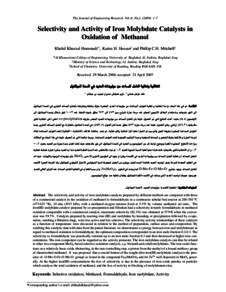وثيقة
Selectivity and activity of iron molybdate catalysts in oxidation of methanol.
المساهمون
Hassan, Karim H., مؤلف
Mitchell, Phillip C. H., مؤلف
الناشر
Sultan Qaboos University
ميلادي
2009
اللغة
الأنجليزية
الملخص الإنجليزي
The selectivity and activity of iron molybdate catalysts prepared by different methods are compared with those of a commercial catalyst in the oxidation of methanol to formaldehyde in a continuous tubular bed reactor at 200-350 oC 623- 473) oK), 10 atm (1013 kPa), with a methanol-oxygen mixture fixed at 5.5% by volume methanol: air ratio. The iron(III) molybdate catalyst prepared by co-precipitation and filtration had a selectivity towards formaldehyde in methanol oxidation comparable with a commercial catalyst; maximum selectivity (82.3%) was obtained at 573oK when the conversion was 59.7%. Catalysts prepared by reacting iron (III) and molybdate by kneading or precipitation followed by evaporation, omitting a filtration stage, were less active and less selective. The selectivity-activity relationships of these catalysts as a function of temperature were discussed in relation to the method of preparation, surface areas and composition. By combing this catalytic data with data from the patent literature we demonstrate a synergy between iron and molybdenum in regard to methanol oxidation to formaldehyde; the optimum composition corresponded to an iron mole fraction 0.2-0.3. The selectivity to formaldehyde was practically constant up to an iron mole fraction 0.3 and then decreased at higher iron concentrations. The iron component can be regarded as the activity promoter. The iron molybdate catalysts can thus be related to other two-component MoO3-based selective oxidation catalysts, e.g. bismuth and cobalt molybdates. The iron oxide functions as a relatively basic oxide abstracting, in the rate-controlling step, a proton from the methyl of a bound methoxy group of chemisorbed methanol. It was proposed that a crucial feature of the sought after iron(III) molybdate catalyst is the presence of -O-Mo-O-Fe-O-Mo-O- groups as found in the compound Fe2(MoO4)3 and for Fe3+ well dispersed in MoO3 generally. At the higher iron(III) concentrations the loss of selectivity is due to the presence of iron oxide patches or particles which catalyze the total oxidation of methanol, and the loss of activity to blocking of molybdenum sites.
المجموعة
ISSN
1726-6742
URL المصدر
zcustom_txt_2
Hummadi, K. K., Hassan, K. H., & Mitchell, P. C. H. (2009). Selectivity and activity of iron molybdate catalysts in oxidation of methanol. The Journal of Engineering Research, 6 (1), 1-7.
الملخص العربي
تم في هذا البحث دراسة انتقائية وفعالية العوامل المساعدة من مولبيدات الحديد المحضرة بطرق مختلفة ومقارنتها بالعامل المساعد التجاري في أكسدة الميثانول إلى الفور ملديهايد وباستخدام المفاعل الأنبوبي المحشو عند درجة حرارة تتراوح بين 473 إلى 623 مطلق بثبوت الضغط عند 1013 كيلو باسكال ونسبة الميثانول إلى الأكسجين 5.5% حجما. أكدت النتائج التي تم الحصول عليها بأن العامل المساعد من مولبيدات الحديد المحضر بطريقه co - precipitation أعطى أعلى انتقائية للفور مالديهايد (82.3%) والتي يمكن الحصول عليها عند درجة حرارة 573 مطلق عندما كان التحول (59.7%) في أكسدة المثانول بالمقارنة مع العامل المساعد التجاري بينما العوامل المساعدة المحضرة بطريقة العجن والترسيب ثم التبخر أعطت أقل انتقائية وأقل فعالية. ثم تمت مناقشة علاقات (الانتقائية - الفعالية) لهذه العوامل المساعدة كدالة لدرجة الحرارة وعلاقتها بطرق التحضير والمساحة السطحية ونسبة التراكيب الكيماوية لهذه العوامل المساعدة. وبربط نتائجنا التي تم الحصول عليها في هذا البحث مع المقالات وبراءات الاختراع المنشورة أظهرنا وبوضوح ترابط كل من المولبيديوم والحديد في أكسدة الميثانول إلى فور مالديهايد حيث كانت أفضل نسبة مئوية من الحديد بحدود 0.2- 0.3 وإن الانتقائية للفور مالديهايد كانت ثابتة عمليا لغاية النسبة المئوية للحديد 0.3 ثم تبدأ بالانخفاض عند النسبة العالية للحديد كما أن الحديد ممكن اعتباره كمنشط لفعالية العامل المساعد إن فعالية العامل المساعد من مولبيدات الحديد في الأكسدة يمكن أن يعود إلى المكونين الآخرين للأساس 3M o0 مثل مولبيدات البزموث والكوبلت. حيث أنه في الخطوة المحددة للسرعة يعمل أوكسيد الحديد كقاعدة أكسده لفصل بروتون من المثيل لمجموعة أصرة الميثوكسي للامتزاز الكيماوي للميثانول وقد اقترحنا الصورة الأكيدة العامل المساعد بوجود مجاميع O - Mo - Fe - O - Mo - O كما وجدت في المكون 3 (Fe (Mo04 وأن سبب الفقدان في الفعالية للعامل المساعد عند التركيز العالي للحديد هو وجود حبيبات أوكسيد الحديد الذي يساعد في الأكسدة الكلية للميثانول وفقدان فعالية صد مواقع المولبيديوم.
قالب العنصر
مقالات الدوريات

